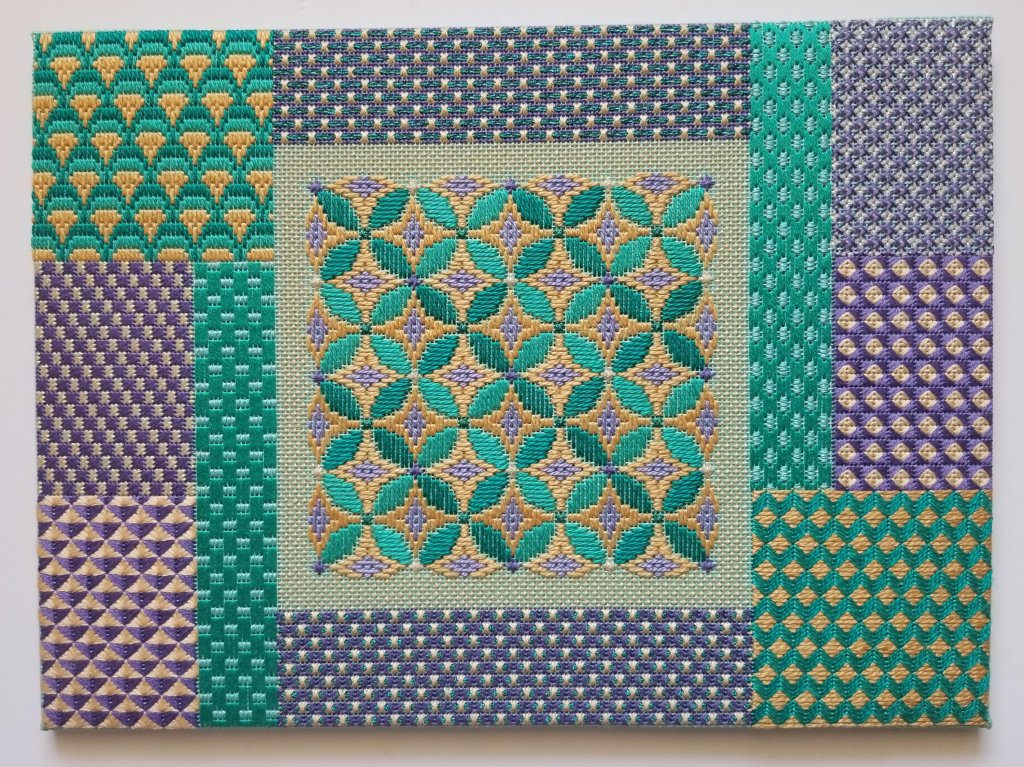Filed under: Backgrounds, The Finishing Touch by Ann Strite-Kurz, Books in My Library, Canvas Applique by Ann Strite-Kurz, Diaper Patterns by Ann Strite-Kurz, Needlepoint Books, Potpoutti of Pattern Encore by Ann Strite-Kurz, Stitch Refinement for Canvas Embroidery by Ann Strite-Kurz, Stitch Variations and Mutations Partsc1 and 2 by Ann Strite-Kurz
Ruby Razzle Dazzle captured my attention and introduced me to Ann Strite-Kurz’s designs. It is a collection of a variety of techniques which looks exceedingly complicated but lovely! I did get the booklet of instructions recently and will get to it. But, it is not a needlepoint book.
The first book in my collection of books by Ann is Diaper Patterns. I needed it in order to create a diaper pattern for Step 3 of the EGA Master Craftsman program. Ann’s inscription to me reads, “Welcome to my world of Diaper Patterns”. What a comprehensive booklet with 131 pages and a CD with about 500 images! The diversity of the outstanding examples are due to many contributors who provided finished pieces and stitch samples. Many of the people I have had a pleasure to meet over the years or take classes from. It’s such fun to read about a piece that I admire even if I haven’t stitched it. Linda from ANG Main Line Stitchers completed Dorothy Lesher’s The Snowbird beautifully and Ann describes and diagrams (with Dorothy’s permission) one of the white and blue patterns which is a diapered variation of the Old Florentine stitch. Ann explains that the white pattern on her dress could be a diaper pattern if the short outline stitches were executed in a contrasting color. With the images Ann provides, this provides hours of entertainment and education. Ann describes a diaper pattern succinctly as “visual diagonals in both directions” and then goes on to describe differences between groundings, stripes, and diapers. Ann describes 8 basic diaper pattern networks which I incorporated into my EGA Master Craftsman piece. I had to use at least 4 patterns and used them all. Or, I thought I had until I sent the image to Ann. Apparently, the center pattern is actually overlapping circles rather than ogees. However, keep your eyes open for a Stitch Refinement Zoom lecture by Ann that she’s working on. My pastel design may be used to illustrate how to use intensity to keep the colors separated.
The Canvas Applique booklet provides step-by-step instructions for mounting regular and irregular shapes of canvas to canvas, reverse applique, kid and ultrasuede applique, gauze applique, stone and mirror settings, and Cretan pockets. There are also a good number of illustrations using her stitched pieces. I have my two small irregular-shaped stitched pieces ready to remove from the bars to mount to my canvas for Step 5 of the EGA Master Craftsman program. I am worried about the mounting process. However, I should take the plunge and start! For those with knowledge of the process, that was an intended pun. For those unfamiliar, you pull all the canvas threads out up to the stitched portion and then weave some to the back of the small piece but most canvas threads get plunged through to the back of the main canvas and woven to the back of the main canvas. My main issue is that the appliques I designed are larger than the minimum one inch square and that is going to be a lot of canvas threads to weave or plunge and weave. But, I’ve read the mounting process several times now and have got to bite the bullet and do it!
The third book I have is Potpourri of Pattern Encore which is a collection of previously unpublished patterns for canvas and counted thread use (129 pages). The Introduction and Techniques chapter includes basics and lots of color photos of various pieces to be discussed in the subsequent chapters with more details about background patterns, border patterns, laid fillings, composite patterns, and diaper patterns. The last chapter analyzes a dozen different stitched color combinations of the same design. Fascinating. Another good book to take a deep dive into.

Updated February 2024.
I was sent Backgrounds, The Finishing Touch by mistake from an Etsy site but didn’t complain after one look inside. It includes another CD with full color plates of the 118 images described in the text. Ann’s husband, Bill, put it together for her. The best husband’s are named Bill! Well, there might be at least one of my blog readers who would disagree with that statement.

In Chapter 1 of Backgrounds, Ann discusses how and why she selected backgrounds for each piece. In subsequent chapters, she discusses planning and execution, darning patterns, back-stitched outlines, textured patterns, and couching patterns.
Stitch Variations and Mutations discusses the structure of stitch families in order to plan stitch variations. The Summary Sheet at the end of Part 1 offers 35 ways to derive stitch variations. Part 2 picks up 16 years later with 16 more ways she’s compiled to develop new stitch treatments.
Stitch Refinement in Canvas Embroidery expands and extends principles discussed in Science of Canvas Embroidery (Ann said I did not need both). Composite stitches and open patterns are followed by solutions to canvas dilemmas such as compensation, stem versus outline stitch, and differences in designs with center holes compared to designs with a center thread.
3 Comments so far
Leave a comment

Thanks for a fantastic review of Ann’s books. I’m now on the hunt for a reasonably priced diaper patterns book,
Comment by brendasneedlepointstudioblog February 26, 2022 @ 10:15 amI doubt there is one more comprehensive than Ann’s book.
Comment by melitastitches4fun February 26, 2022 @ 10:57 am[…] Since I keep books organized by author on my blog, I have updated my original post on Ann’s books: https://melitastitches4fun.com/2022/02/25/books-in-my-library-canvas-applique-diaper-patterns-and-po… […]
Pingback by Books in My Library: The Canvas Embroidery Notebook by Mindy English & a Book Mix-up! | Melitastitches4fun's Blog February 8, 2024 @ 12:15 am